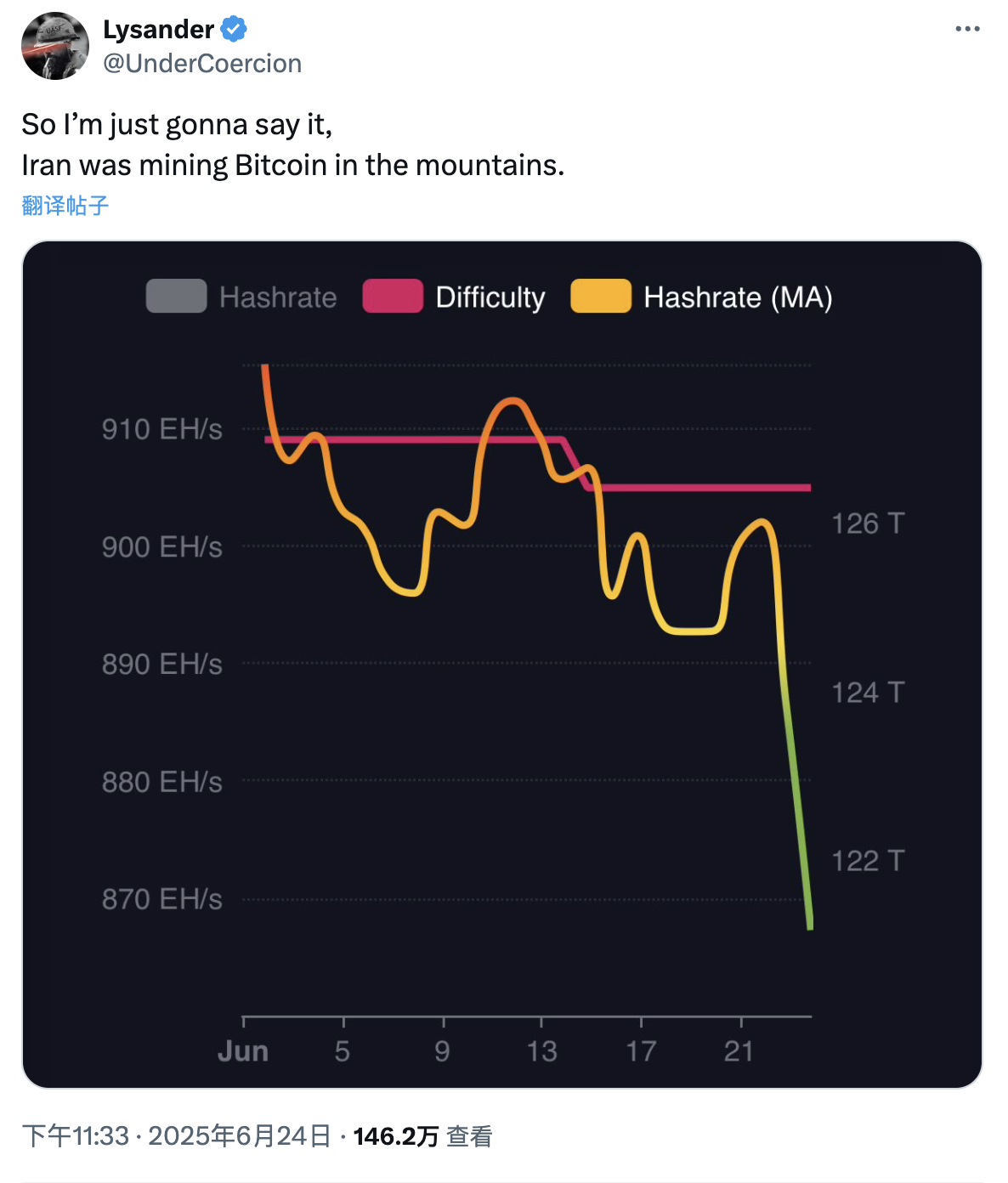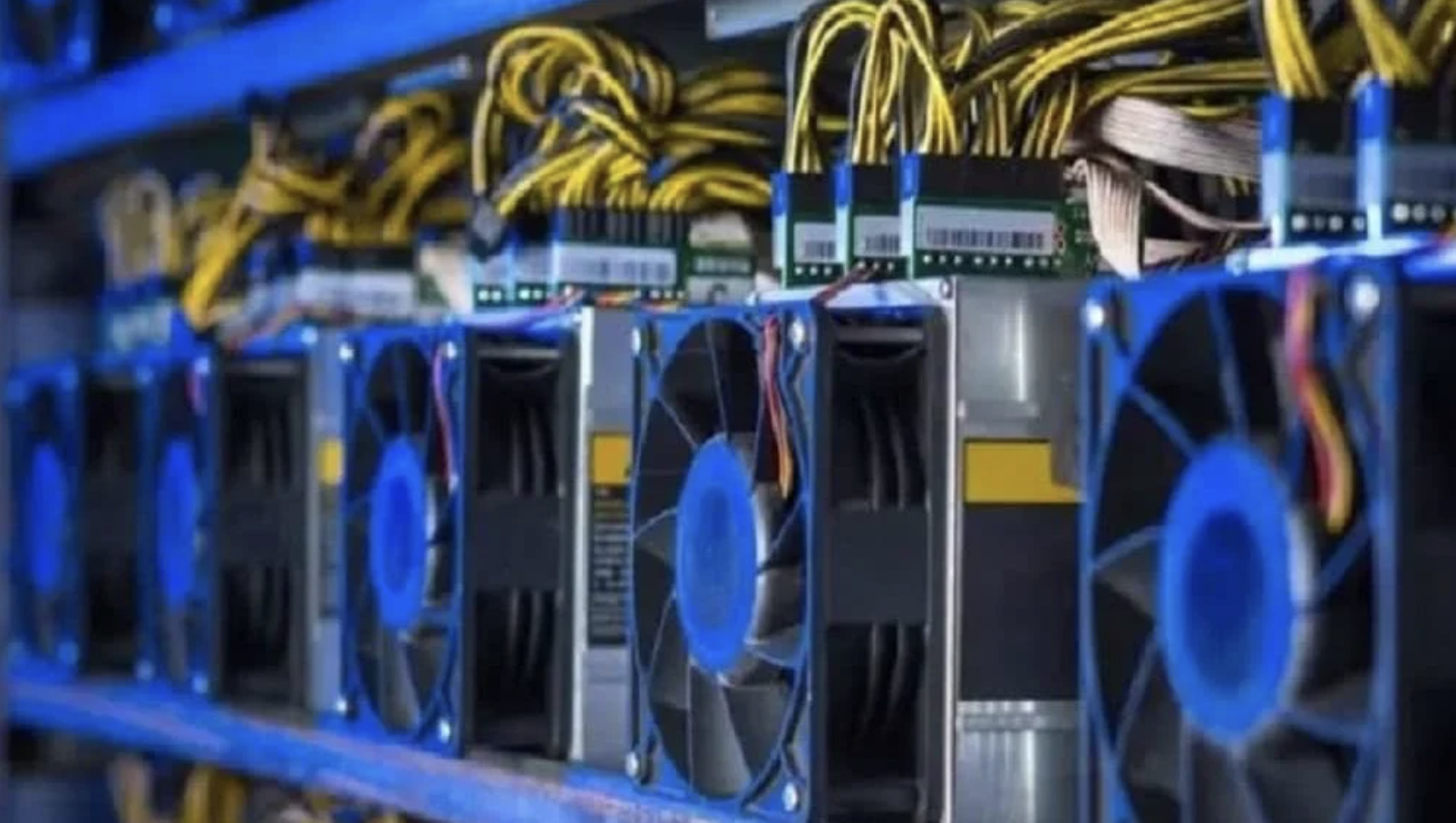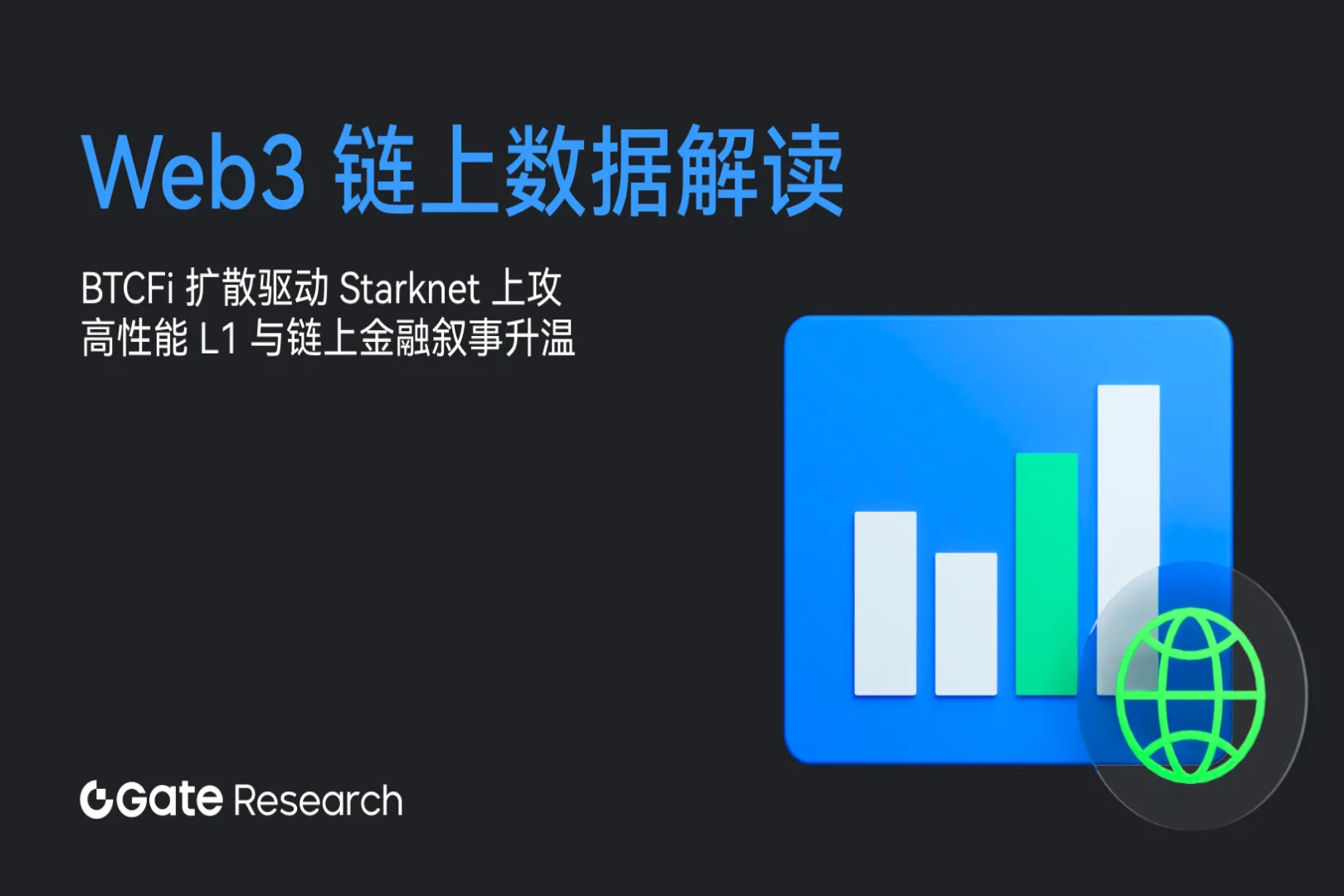A brief history of mining in Iran: We sat in the dark, just to keep the Bitcoin miners running
This article comes from: NCRI ; original author: Shahriar Kia
Compiled by Odaily Planet Daily ( @OdailyChina ); Translated by Azuma ( @azuma_eth )
Editor's note: With the conclusion of a ceasefire agreement, the geopolitical conflict between Iran and Israel seems to have temporarily subsided, but the aftermath of the war has not yet dissipated.
On June 21, local time, the United States bombed three Iranian nuclear facilities in Fordow, Natanz and Isfahan through the so-called "Midnight Hammer" operation. On the same day, the Bitcoin hash rate average also fell sharply. This unexpected coincidence made the cryptocurrency community speculate: "Is Iran using its nuclear facilities to secretly mine Bitcoin?"

Although Galaxy research director Alex Thorn clarified from a technical perspective that "the hash rate is inferred from block time and difficulty, and the current evidence is not sufficient to determine whether the computing power has dropped. More time and moving average observations are still needed", Alex Thorn also said that Iran may be mining and the mining website may have been attacked.
The story of Iran’s mining is not new. In May this year, the Iranian opposition organization NCRI published a long article outlining the many years of history of Bitcoin mining in Iran. The following is the full text.

Iranian government-linked Bitcoin mining farms consist of rows of “specialized computer servers” (ASIC miners) that devour electricity on an industrial scale. In recent years, crippling power outages have occurred frequently across Iran, plunging homes into darkness and shutting down factories for hours or even days. Investigations are increasingly pointing to a hidden driver exacerbating the crisis: large-scale cryptocurrency mining operations operated or harboured by Iranian government actors, particularly the Islamic Revolutionary Guard Corps (IRGC).
These secret or semi-official Bitcoin mines consume enormous amounts of electricity, often operating at highly subsidized rates or even completely free of charge, essentially diverting energy from the national grid to private profit.
The rise of Bitcoin mining in Iran
Iran's involvement in cryptocurrency mining began in the late 2010s, when the country was looking for innovative ways to break through its economic isolation. After the United States resumed sanctions in 2018, the government saw cryptocurrencies as a tool to bypass banking restrictions and generate revenue. In 2019, the religious regime officially recognized crypto mining as a legal industry, introduced a miner licensing system, and attracted investment with cheap electricity, on the condition that all mined Bitcoins must be sold to the Central Bank of Iran.
The prospect of subsidized electricity has attracted domestic powers and foreign partners, especially Chinese investors, who have set up large Bitcoin mines in Iran’s free trade zones and remote warehouses.
Iran’s energy sector was quick to notice the impact. In mid-2019, authorities attributed an “unusual” 7% spike in electricity consumption nationwide to a proliferation of unregistered crypto mining farms. Sporadic reports showed mining machines turning up in unexpected locations, from abandoned factories to government offices and even mosques enjoying free or ultra-cheap electricity. Thousands of illegal mining machines were confiscated as officials realized that many miners were operating covertly to take advantage of electricity at well below market prices.
As of 2020, the government has issued licenses for about 1,000 crypto mining farms, but most mining activities remain underground. Former President Rouhani admitted in 2021 that about 85% of mining in Iran is unlicensed - this huge gray economy consumes electricity but is not regulated or paid for.
Behind this boom is Tehran's need to monetize its abundant energy resources under sanctions. Bitcoin mining essentially converts energy into cryptocurrency value. Due to restrictions on oil exports, the regime has achieved energy "export" by using excess oil and natural gas to generate electricity and mining, and then selling the resulting Bitcoin overseas in exchange for hard currency or imported goods. It is estimated that as of 2021, 4.5% of the world's Bitcoin mining takes place in Iran, generating "hundreds of millions of dollars" in crypto asset revenue for the sanctions-hit economy.
Islamic Revolutionary Guard Corps enters
As of 2019-2020, reports indicate that the most influential power group in Tehran - the Islamic Revolutionary Guard Corps (IRGC) and entities controlled by Supreme Leader Ayatollah Ali Khamenei - has made a major push into cryptocurrency mining. Under Khamenei's instructions, the IRGC has partnered with overseas companies to build large-scale mining farms to earn Bitcoin and make up for the loss of Iran's dollar channels. A typical case is a 175-megawatt Bitcoin mine in Rafsanjan, Kerman Province, which is nominally a joint venture between IRGC-affiliated companies and overseas investors, who were attracted by Iran's extremely low electricity prices.
These mines are often located in special economic zones or military bases controlled by the IRGC, with exclusive power supplies and little regulation. Investigative reports have pointed out that IRGC-affiliated organizations - including large religious foundations such as Astan Quds Razavi - have formed a de facto "crypto cartel" that profits by plundering state electricity. These state-backed miners actually use electricity for free (or simply refuse to pay the bills), and operate unscrupulously with political connections and armed protection.
Multiple sources have confirmed that the Iranian regime grants its military and security agencies special privileges in the field of mining. In 2022, parliament quietly passed a bill allowing the military to build private power plants and transmission lines. This allows the IRGC to directly access subsidized electricity (even publicly owned electricity resources) - infrastructure that should have been used to supply cities and industries, but is now used for secret crypto mining farms.
Regulators have done little to curb these practices. When the Ministry of Energy attempted to shut down an illegal mine in 2021, IRGC fighters directly obstructed a raid to ensure mining was not disrupted. The Ministry of Intelligence’s refusal to intervene against the IRGC further demonstrates the immunity of the Revolutionary Guards’ mining operations. While authorities openly crack down on small-scale “illegal” miners, large mines operated by or for regime insiders often remain unscathed.
It is estimated that more than half of the mining equipment in Iran is controlled by state-backed entities. Survey data shows that as of 2023, there are about 180,000 crypto mining machines in operation in Iran, of which about 100,000 belong to the state or its affiliated companies (such as the Islamic Revolutionary Guard Corps). This means that the Revolutionary Guard Corps and its partners actually control the majority of Iran's crypto mining capacity under the cover of "legal industry". These actors put mining and the benefits it brings above people's livelihood needs.
It is worth noting that even as the energy crisis intensified, the Revolutionary Guard’s media outlets continued to divert attention by publicizing their actions to “crack down on illegal mines” - a public relations tactic that is ironic because electricity regulation is not the Revolutionary Guard’s responsibility, and the mines it operates are at the heart of the problem.
Electricity consumption at Iranian Bitcoin mining farms
The scale of energy consumption by Iran’s crypto mining farms, especially those backed by the state, is staggering. While precise data is difficult to obtain due to the secrecy surrounding the operations of the facilities, both official and independent assessments confirm that mining farms have become a significant burden on Iran’s power system.
Multi-gigawatt load
Data from the Ministry of Energy shows that during peak hours, crypto mining can consume up to 2,000 megawatts (2 gigawatts) of electricity - equivalent to the output of 2-3 nuclear power plants , despite government orders requiring mining farms to shut down during power shortages. In late 2024, energy officials noted that illegal mining alone caused a 16% year-on-year surge in national electricity demand.
This is consistent with earlier reports that unlicensed mining farms consumed about 2 GW of electricity in 2020-21, when Iran's total power generation capacity was only 60-70 GW . For reference, 1 GW of electricity can meet the daily needs of a city with hundreds of thousands of people - so the impact of 2 GW of electricity consumed by mining is extremely significant.
Official Seizure and Assessment
Iran's national power company, Tavanir, continues to conduct an operation to clear illegal mining machines. Authorities claim that more than 252,000 illegal mining machines have been seized since the beginning of 2022. Officials said that if these devices continue to operate, they will consume about 4 gigawatts of electricity. "This is equivalent to the total electricity consumption of three or four small provinces in Iran," said the vice president of Tavanir.
Even after large-scale seizures, tens of thousands of unregistered mining machines continue to operate - and many licensed high-energy-consuming mines (including state-backed mines) have never been included in the scope of rectification. In early 2023, a spokesman for Iran's Ministry of Energy admitted that about 0.8 gigawatts (800 megawatts) of the country's electricity demand at the time came from crypto mining (most of which was illegal). This number may seem small, but it may become the critical point where the power grid is forced to implement power rationing during peak power consumption. For every 100 megawatts of electricity occupied by mining farms, 30,000 households or factories and office buildings of corresponding size lose power supply security.
Cheap electricity = huge profits
Iran's extremely low subsidized electricity prices (some users only pay $0.01-0.05 per kWh) make crypto mining extremely profitable. Analysis shows that the cost of mining a single Bitcoin in Iran can be as low as $1,300, while the global market price of Bitcoin will reach $30,000-40,000 by the end of 2024. The 20-30 times profit margin explains why entities such as the Revolutionary Guard are willing to take risks in illegal mining.
The intensity of its energy consumption is shocking: a single Bitcoin consumes more than 300,000 kilowatt-hours of electricity - equivalent to the total electricity consumption of 35,000 Iranian households in a single day. In other words, for every Bitcoin produced by these mines, it is equivalent to tens of thousands of households being cut off from electricity for a whole day. Former Energy Minister Reza Ardakanian once warned that according to some statistics, cryptocurrency business consumes nearly 10% of Iran's total electricity generation.
Global share and oil equivalent
In 2021, Iran’s Bitcoin mining accounted for about 4%-8% of the global network. Although crackdowns and mining difficulty adjustments have reduced its share (officially to 0.5%-1% in 2022 and less than 0.1% at the end of 2024), Iran remains an important player. Elliptic analysts calculated that in 2020, Iran’s mining machines consumed about 10 million barrels of crude oil per year to generate electricity, equivalent to 4% of Iran’s oil exports at the time. This contrast sharply reveals that Iran is burning up oil and gas resources that could have been exported or used for civilian purposes just to produce Bitcoin.
It’s important to note that Iran’s power crisis is not entirely caused by Bitcoin mining . Decades of underinvestment, overconsumption fueled by subsidies, and mismanagement have strained the power infrastructure. Experts point to aging power plants and mismanaged fuels exacerbating seasonal shortages. But the consensus is that unregulated crypto mining, especially by those protected by power, has become a major source of stress for the grid—these mines drive up overall demand and continue to operate during peak hours, greatly exacerbating the pressure on power supply.
Power outage crisis evidence
Since 2019, Iranians have been experiencing rolling blackouts, which have become increasingly severe in recent years. The summer heat drives up air conditioning energy consumption, while winter heating demand and power plant fuel shortages make the situation even worse. Crypto mining has exacerbated this pressure in both directions and has even been explicitly included in emergency response measures.
2021: Blackouts and mining bans
In January 2021, sudden power outages in Tehran and other major cities sparked public outrage. Officials blamed a surge in illegal mining (combined with drought that cut hydropower production). In June of the same year, power outages continued to worsen before the election, and President Rouhani was forced to issue a four-month (May-September 2021) total mining ban. He pointed out that unlicensed mines consume huge amounts of electricity and promised to crack down on them.
At the time, Iran's peak electricity demand was about 60,000 megawatts, and the closure of the mines was expected to free up thousands of megawatts of electricity. Global data also showed that Iran's share of Bitcoin computing power briefly fell during the ban. But enforcement was spotty - especially for Revolutionary Guard-affiliated mines - and power outages continued in the summer of 2021. The government acknowledged that mining was one of the causes of the "dark summer", alongside high temperatures and aging infrastructure.
2022-2023: Continued shortages and local measures
After the ban was lifted in 2021, both legal and illegal mining activities rebounded. Before the winter of late 2022, the state power company warned that illegal mining would cause 10% of power outages that season. Although the authorities required licensed mines to shut down during peak power consumption and claimed to track down illegal mines, the results were limited.
Iran still faces a so-called “power gap” as of mid-2023. The Energy Ministry again blames unlicensed miners for exacerbating the shortage, while urgently hauling in fuel for power plants and importing electricity from neighboring countries. Power outages remain frequent in summer and winter, though slightly less extensive than the 2021 crisis.
Summer 2024: The “Super Crisis”
In the summer of 2024, Iran experienced its worst heat wave in 50 years, with record electricity consumption. In August, government agencies and schools in 27 of the country’s 31 provinces were forced to close in whole or in part to save electricity. Even with these extreme measures, many places still implemented planned power outages. Iranian media called it a “super crisis” and reported that the economic losses from power outages exceeded $25 billion per year.
Industry was hit hard - steel mills, cement plants and other large electricity users stopped production for several days due to power cuts. As public discontent boiled over, officials once again singled out illegal mining as an exacerbating factor (along with extreme weather). The then-energy minister offered a reward for reporting underground mines, acknowledging that unlicensed miners' consumption of subsidized electricity "severely impacted the power grid and violated public rights."
Winter 2024-25: Cold snap power outages
The changing seasons have not eased the crisis. A cold snap in late 2024 caused a shortage of natural gas (most Iranian power plants run on gas), and blackouts reappeared in major cities. Although officials have ordered all licensed mines to close, it is widely believed that some mines owned by powerful people are still operating. Investigations have shown that some mines, including facilities associated with the Revolutionary Guard, continued to operate with lights on during peak grid stress, while surrounding communities were plunged into darkness. This selective enforcement has exacerbated public anger and suspicion.
The government rarely publicly acknowledges the "contribution" of mining within the system to power outages, usually attributing it to the increase in residential electricity consumption, drought or excessive use of air conditioning. But the public and independent observers have long since figured out the truth. By 2025, Iranian slogans and social media frequently criticized the "power theft mafia". Even some within the system lawmakers and former officials have criticized the indulgence of mining, which is destroying the already fragile power grid.
The cost of livelihood
The secret transfer of large amounts of electricity to the cryptocurrency mining industry has brought real pain to the daily lives of Iranians. Every megawatt of electricity consumed by Bitcoin mines means one megawatt less for homes, hospitals and factories. This diversion of national electricity for private use is directly harming ordinary people in many ways.
Family Dilemma
In communities with frequent power outages, residents have to endure scorching summers without air conditioning and cold winters without heating. Food in refrigerators spoiled, and tap water supplies that rely on electric pumps were interrupted. In July 2021, many residents of Tehran were trapped in elevators or stranded on dark roads due to sudden power outages. By 2024, power outages had become commonplace, and people even jokingly shared "power-rationing schedules" on social media to arrange their lives. Most outrageous is that while citizens are asked to save electricity, certain facilities protected by the regime are devouring electricity 24 hours a day. As one Iranian said: " We sit in the dark just to keep the Bitcoin miners running. "
Medical and safety crisis
Continuous power outages threaten critical public services. Although hospitals can keep life-support equipment running with backup generators, not all clinics have reliable backup power. During the 2024 summer blackout, some small city hospitals had to postpone surgeries and transfer patients because air conditioning stopped working.
Traffic lights and street lamps went out, causing frequent accidents, and darkness at night created more safety hazards . Ironically, while hospitals were in darkness, Revolutionary Guard bases and mines were brightly lit - a stark contrast that exposed distorted priorities.
Economic losses
The power outages have cost Iran's economy tens of billions of dollars. From bakeries to processing plants, small businesses have been forced to close, while heavy industries such as steel and cement face equipment damage and delivery delays. Energy industry media "Pakistan Electricity News" estimates that the country loses more than $25 billion each year due to power outages, which ultimately translates into rising prices, unemployment, and reduced services borne by the entire society. This widening gap between supply and demand is largely due to the hidden power consumption of crypto mining.
Pivot
As mentioned above, mining one bitcoin consumes about 300 megawatt-hours of electricity, which is equivalent to the daily electricity consumption of 35,000 households. According to another calculation, Iranian officials said that each mining machine consumes as much electricity as 10 households. The continuous operation of tens of thousands of mining machines means that the electricity that could illuminate hundreds of thousands of households is being consumed by mining machines. During the peak of electricity consumption in summer, this kind of power distribution may even cause the entire provincial capital to fall into darkness. No wonder Iranian public opinion increasingly calls the official secret mining "stealing the lights of thousands of households."
Public outrage and scapegoats
As electricity bills rise, public anger is growing, with more and more people realizing that this is essentially a corruption phenomenon where the privileged class enrich themselves while ordinary people suffer from power outages.
Official media still points the finger at the public's "overuse of electricity" or technical failures, deliberately downplaying the impact of mining within the system. But this rhetoric is becoming increasingly ineffective. People generally suspect that the "illegal mines" that have been investigated are just small fish and shrimps, and the real power black holes are large mines protected by the Revolutionary Guard. In fact, each raid is mostly aimed at small mining machines in remote farmhouses or residential houses, while warehouses in military restricted areas are safe and sound. This selective law enforcement has intensified the public's ridicule and eroded people's trust in the government's sincerity in solving the power crisis.
A costly gamble
What was initially an "innovative measure" to deal with sanctions has now turned into a self-inflicted energy crisis. Iran's "state-backed Bitcoin mining experiment" promoted by the Islamic Revolutionary Guard Corps and other power centers has exchanged hard currency for hard currency, but at the cost of the collapse of the power grid. For the ruling elite, the Revolutionary Guard's encryption business is lucrative, but in fact it is parasitic on the country's economy and infrastructure - every Bitcoin produced under its protection means more crazy fossil fuel consumption, more serious pollution emissions, and longer dark times for businesses and families.
In order to circumvent sanctions, Tehran accidentally fostered an "energy black market" dominated by privileged institutions. The consequences were disastrous: institutionalized corruption, increased capital flight, and the continued weakening of the state's control over the energy system.
For tens of millions of Iranians, hope lies in a more transparent and modern energy policy - ending the privileges of the "crypto monopoly" and returning electricity to its public attributes. Unless the shadow network behind the Revolutionary Guard is cut off or truly regulated, there is no solution to the crisis. The power grid will continue to be overloaded, and the people will still have to bear the price in flickering bulbs and sweltering summer nights.
Iran’s current situation is a warning. When mining becomes a tool for the privileged class to make money, it not only destroys energy security, but also ignites public resentment and pushes the entire country to the brink of collapse.



